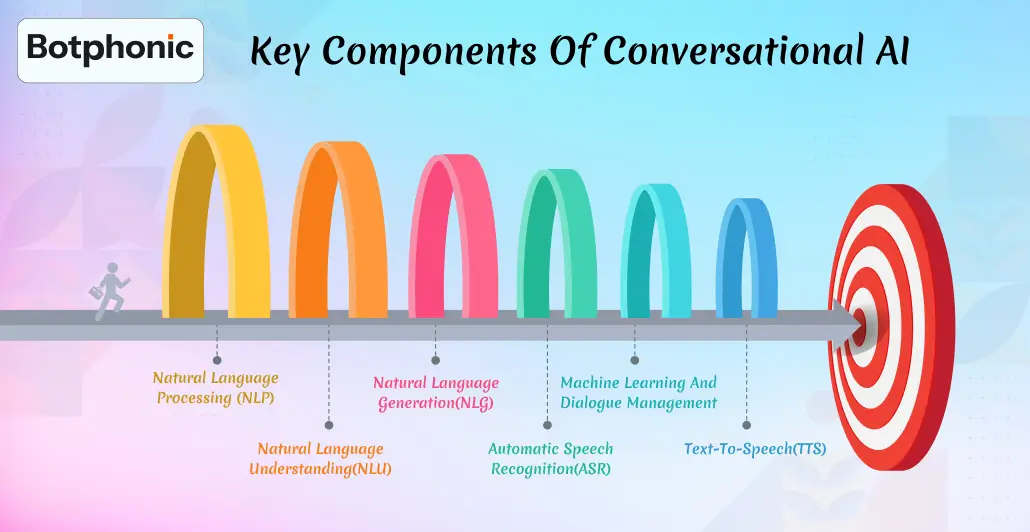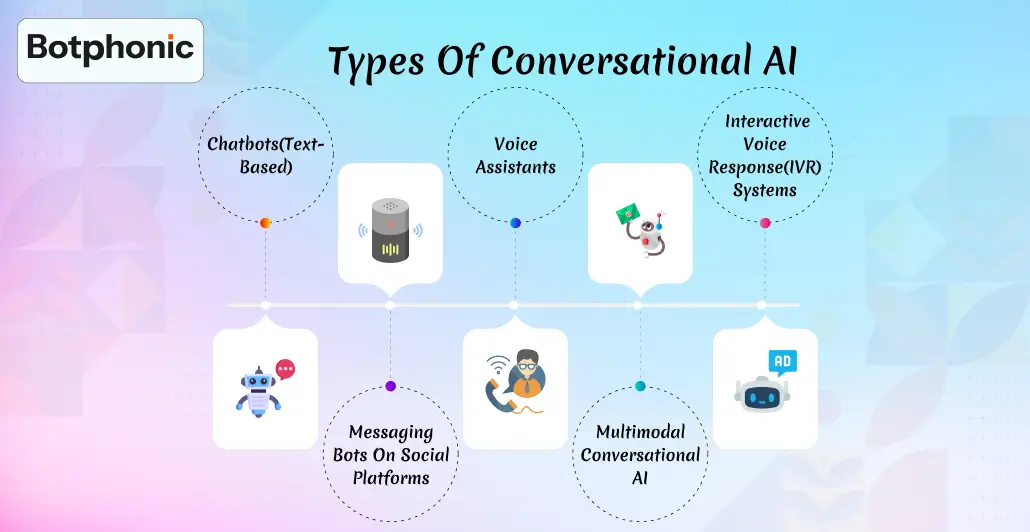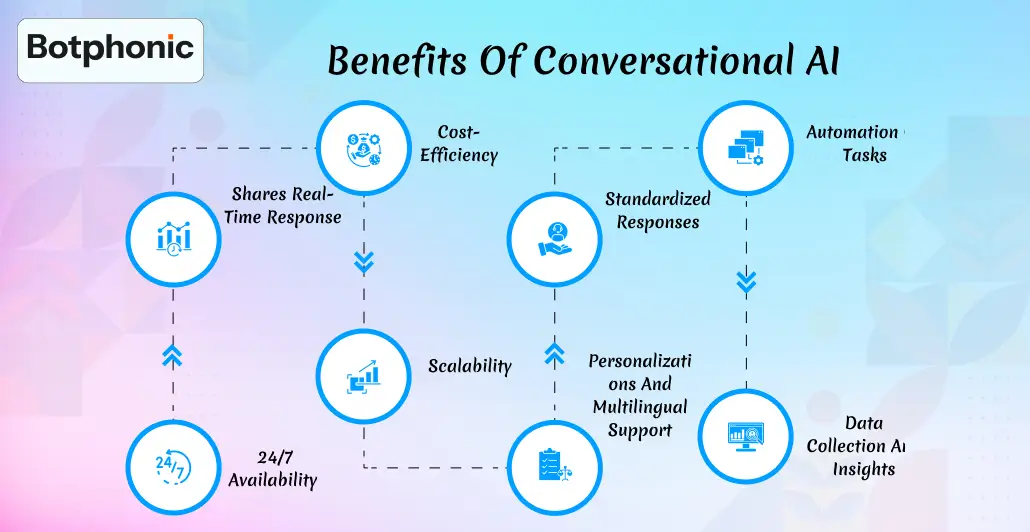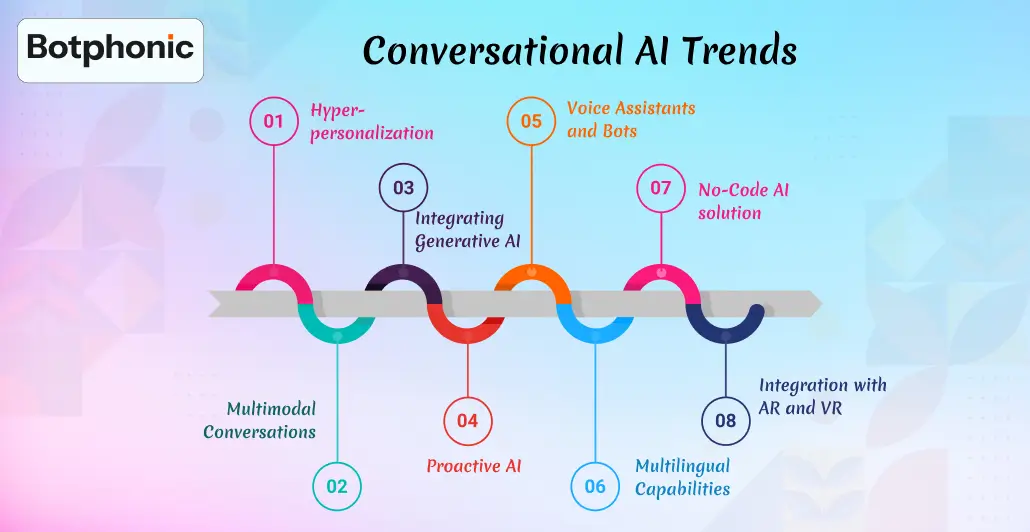
Summarize Content With:
Quick Summary
There might have been times when you were tasked with numerous chats and calls to engage and solve the queries of customers. It might have been possible that a few of them had the same query, and a few of them had some passive-aggressive behavior towards you, which in turn had made you stressed, too. But these days, there’s something that can help you get free from these issues and focus on potential work, which can even make you feel good.
In this blog, we are going to learn how we can get free from these workloads with conversational AI while potentially growing.
Introduction
Conversational AI is a type of artificial intelligence that helps even machines acknowledge and process human language to share relevant responses to them. Whether it’s verbal or nonverbal, it doesn’t matter, as it just imitates natural human conversation. AI can be used in various forms such as virtual assistants, chatbots, voicebots, and even automated messaging systems.
What is Conversational AI?
Conversational AI is an array of technologies that enables machines or relevant gadgets to learn, understand, interpret, and even create a response. It usually relies on Natural Language Processing (NLP) to analyze and understand the intent of what the user has requested. It has become advanced with real-time conversational AI integration for effective operational efficiency.
Key Components of Conversational AI:

Conversational AI is not just a single component but a set of components that work together to gather perfect responses. The key components of the same are as follows:
1. Natural Language Processing (NLP)
- It helps understand and interpret the user’s language.
- Simply breaks down the structure of sentences in grammar, context, and intent to interpret them accordingly.
2. Natural Language Understanding(NLU)
- NLU is usually considered a subfield of NLP, which emphasizes identifying the meaning, intent, and sentiment followed by the user’s request.
3. Natural Language Generation(NLG)
- It assists in converting the machine-generated response into human-like language for a better and clearer response.
4. Automatic Speech Recognition(ASR)
- ASR helps transcribe the spoken language into text form, which is widely used in voice assistants.
5. Machine Learning and Dialogue Management
- This enables them to learn from previous interactions with users.
- It effectively determines the flow and logic of conversations for better input.
6. Text-to-Speech(TTS)
- Transfigures the text responses into speech for effective spoken output.
How does it work?
Conversational AI works by combining a set of technologies that allow machines to understand and respond to human language most naturally and conversationally. It effectively uses NLP and Machine learning to enhance its efficiency and interpret the user’s intent.
Here’s a detailed version of the key components
1. Input Gathering
- The user first interacts with agents through text or voice.
- The input might also be received through websites, apps, or even other interfaces.
2. Input Analysis
- NLU effectively analyzes the input from the user and understands the meaning and intent behind the message.
- If the input is presented in voice, the speech is converted into text using ASR for NLU to process.
- Conversational AI agents
3. Dialogue Management
- This stage mainly manages the flow and context of the conversation for better understanding.
- Dialogue Management actively remembers the previous conversations and ensures the responses are aligned and relevant.
4. Response Generation
- Natural Language Generation is a component of NLP, it formulates a response solely based on the analyzed input and context of said dialogues by the user.
- The responses can vary from text to speech, it will depend on the interface used for the concern.
5. Machine Learning
- Machine learning algorithms are typically used to analyze user interaction and improve their responses over time.
- It helps AI learn patterns and improve its accuracy over time.
Basically, conversational AI integrates NLP and machine learning together to create a system that acknowledges the intents and shares responses to human language that feel natural to them, too, and is easily understandable.
Types of Conversational AI

There are different types of conversational AI, which usually depend on how advanced the technology you are opting for is and the method of communication it uses.
Here are the few main types, which are widely used:
1. Chatbots(Text-based)
- Rule-Based Chatbots
- Rule-based conversational AI bots are usually text-based and usually follow predefined rules or scripts that are provided to them.
- For Example, A website chatbot that can answer FAQs by detecting keywords shared by users and customers.
- AI-Powered Chatbots
- It usually uses machine learning and even NLP to understand the user’s request and share responses based on the same.
- For Example, there are banking bots that help with balance checks, transfers, and FAQs. It can learn from interactions with the user and improve over time effectively.
2. Voice Assistants
- Conversational AI voice assistants effectively include software such as speech recognition, TTS, and others that interact with consumers.
- For Example: Siri, Google Assistant, and even Alexa.
3. Interactive Voice Response(IVR) Systems
- It refers to phone-based systems that use voice-based conversational AI or even keypad inputs to navigate menus and perform requested tasks effectively.
- For Example, you are asked, “Press 1 for instructions in Hindi”, and “Press 2 for instructions in English.”
4. Messaging Bots on Social Platforms
- Messaging Bots are typically deployed on various platforms like WhatsApp, Facebook Messenger, or Telegram to interact with customers and engage them in resolving their queries.
- For Example, A bot available on Messenger that helps you track your orders or even book appointments.
5. Multimodal Conversational AI
- It works by combining text, voice, images, video, and gesture recognition for better and richer interactions.
- For example, a smart device that shows visual content along with speech responses.
Summary Table:
| Type | Input/Output | Intelligence Level | Use Case Example |
| Rule-Based Chatbots | Text | Low | FAQ bots on websites |
| AI-Powered Chatbots | Text | High | Banking or e-commerce chatbots |
| Voice Assistants | Voice | High | Smart home devices (e.g., Alexa) |
| IVR Systems | Voice/Keypad | Medium | Call center automation |
| Messaging Platform Bots | Text | Medium–High | Appointment booking via Messenger |
| Multimodal Conversational AI | Text/Voice/Visual | High | Smart displays or robots |
Benefits of Conversational AI

Conversational AI technology offers various benefits for businesses, which are primarily focused on improving customer experience, increasing operational efficiency, and driving business growth exponentially.
Here’s a breakdown of key benefits, especially focusing on businesses, customers, and developers
1. 24/7 Availability
- Your conversational AI virtual assistant doesn’t need a sick leave or even a tea break. It can give you its 100% output even on holidays and days that you are not available.
- It helps provide customer support anytime they need it.
2. Shares Real-Time Response
- Real-time conversational AI helps you eliminate waiting times.
- It helps us enhance the user experience with faster support service.
3. Cost-Efficiency
- A conversational AI assistant helps you lessen the need for vast customer support teams.
- It allows for making a good amount of savings in labor and operational costs.
4. Scalability
- This can handle a number of inquiries at once and engage them simultaneously.
- It helps easily scale to meet business demand.
5. Standardized Responses
- Conversational AI systems ensure the delivery of the same and accurate information that is provided by the user.
- It reduces the risk of errors occurring by humans and ensures a positive customer experience.
6. Personalizations and Multilingual Support
- These systems effectively use the data to tailor conversations for individual users based on past purchases and preferences.
- It grows the rate of user engagement and satisfaction rate, potentially.
7. Automation of Tasks
- Assists with automating common queries such as password resets, order tracking, and even appointment bookings.
- It helps human agents to focus on major and more complex tasks.
8. Data Collection and Insights
- By capturing the user intent, common questions, and even feedback shared by the user helps in collecting data and making a better insight for the same.
- It helps businesses improve their business strategy, products, services, and even decision-making.
Conversational AI Trends

Conversational AI is evolving rapidly, with growing trends like hyper-personalization, multimodal interactions, and even enterprise workflows. Key trends include proactive conversations, voice-driven AI, and also focus on ethical AI and governance.
Some key conversational AI trends are as follows:
1. Hyper-personalization
AI is adapting to human requirements and is offering tailored interactions based on user data and preferences. It enables you to work on making more relevant and engaging experiences.
2. Multimodal Conversations
This enables users to interact with AI through several channels, which include text, voice, and even visuals. It helps create an effortless and instinctive experience. Enabling the integration of vast and new data types and sharing an enhanced contextual understanding.
3. Integrating Generative AI
Generative AI is transforming the field of conversational AI by allowing natural, engaging, and even customized experiences. It allows the system to manage complex queries. While having dynamic and adaptive conversations using style adaptation, and automated content generation.
4. Proactive AI
It usually refers to a system where AI initiates the conversation with the user using old data and predefined conditions. Usually seen in e-commerce, customer service, smart homes, and even in the healthcare sector. This helps you enhance user experience and even increases engagement.
5. Voice Assistants and Bots
These are forms of conversational AI, but they differ significantly in their functional ability and interaction with the user. Designed to be versatile and can be accessed through different devices and platforms, too. Voice bots are task-specific and customer service-focused.
6. Multilingual Capabilities
Conversational AI is surpassing the ability to interact in additional languages, but it’s rather being inclusive of multilingual users, enhancing its capability and user experience. It’s able to comprehend and generate responses in more than one language while handling linguistic nuances too.
7. No-Code AI solution
With evolving advancements in AI, no-code platforms are making it simpler and easier for companies to build and manage their own conversational AI solutions, even without requiring immense research for the same.
8. Integration with AR and VR
As humans are advancing, so is AI too. Conversational AI can now easily be integrated with augmented reality (AR) and virtual reality(VR) experiences. This results in an improved and positive user experience. It can also be easily applied across various industries.
These trends are not just evolving conversational AI but helping humans too, in increasing their efficiency and challenging their creativity. These are also becoming emotionally aware AIs, which are more than capable of just responding to the scripted version but to the user’s emotions, leading to more engaging interactions. It is also known and typically used for training employees regarding the same, and then evaluating them. Conversational artificial intelligence platforms are also enhancing search functionality, and making it easier for their user to find and implement the information.
Why Is It Important?
Integrating conversation AI in your business helps you know how humans are interacting with technology, and it is equally beneficial for both. It makes communication more natural, efficient, and even accessible. It helps:
- Improve customer experience
- Boosts business efficiency
- Allows personalization at scale
- Break barriers and expand accessibility
- Shares visible and actionable insights
Conclusion
Conversational AI actively helps you bridge the gap between humans and gadgets; it helps transform both how a person is communicating and how a particular organization operates. It is being effectively used in healthcare, finance, retail, education, and even more. With its strategic insights, it helps a business grow efficiently and drive innovation across industries. It is actively changing the game and is proving how it is best for the business in its own way.

